 The Mystery of the Monarchs: How Kids, Teachers, and Butterfly Fans Helped Fred and Norah Urquhart Track the Great Monarch Migration by Barb Rosenstock and Erika Meza (illustrator) is a fascinating and absorbing account of how the mystery of where millions of monarch butterflies migrate over the winter was solved by Fred Urquhart, a Canadian professor of zoology and hundreds of citizens from three different countries. Fred, who lived in Toronto was a “bug man,” from the time he was eight. One of the bugs that fascinated him was the monarch butterfly. He knew a lot about the monarchs including that “during the fall, the monarchs disappeared.” Fred even wrote to a famous professor. “He asked: ‘Where do the monarchs go? He got a surprise answer: No one knew…. It was a mystery that Fred wanted to solve….” For ten years as he worked as a scientist he tried different methods of tagging the butterflies, but never heard back from anyone who found the tagged insects. Continue reading
The Mystery of the Monarchs: How Kids, Teachers, and Butterfly Fans Helped Fred and Norah Urquhart Track the Great Monarch Migration by Barb Rosenstock and Erika Meza (illustrator) is a fascinating and absorbing account of how the mystery of where millions of monarch butterflies migrate over the winter was solved by Fred Urquhart, a Canadian professor of zoology and hundreds of citizens from three different countries. Fred, who lived in Toronto was a “bug man,” from the time he was eight. One of the bugs that fascinated him was the monarch butterfly. He knew a lot about the monarchs including that “during the fall, the monarchs disappeared.” Fred even wrote to a famous professor. “He asked: ‘Where do the monarchs go? He got a surprise answer: No one knew…. It was a mystery that Fred wanted to solve….” For ten years as he worked as a scientist he tried different methods of tagging the butterflies, but never heard back from anyone who found the tagged insects. Continue reading
WOW Recommends
WOW Recommends: Book of the Month


WOW Recommends: A Land of Books: Dreams of Young Mexican Word Painters
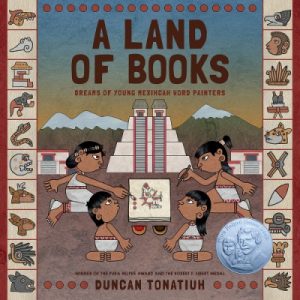 In his new book, A Land of Books: Dreams of Young Mexican Word Painters, Duncan Tonatiuh weaves verbal and visual narratives together to create an historic account of how the “Mexhicah who dwell in the valley of the volcanoes, make books….”
In his new book, A Land of Books: Dreams of Young Mexican Word Painters, Duncan Tonatiuh weaves verbal and visual narratives together to create an historic account of how the “Mexhicah who dwell in the valley of the volcanoes, make books….”
Long ago, before woodblock printing, moveable typeset and the printing press, the Mexhicah made books by painting images onto long strips of amatl, or paper, made from the bark of the amacuahuitl tree. The long strips of paper were folded accordion style and then bound by covers made from wood that were decorated with hides, feathers and jewels. The reader of the amoxtli (book) would unfold the pages so that it could be read. When the reader had finished, the amoxtli was folded and stored in the amoxcalli, the house of books. The tlahcuilohqueh, the painters of words, mixed plants and insects with clay, ash and water to create the paints they used to record the stories of the past and the present, and from which future generations would read to learn about the lived experiences of the Mexhicah.
Fortunately for readers of Duncan Tonatiuh’s newest amoxtli, the future is upon us. In Tonatiuh’s picturebook, he tells a story of Mexhicah book making from the perspective of the daughter of a tlahcuilohqueh. The young girl explains to her brother how their parents make the amoxtin. She tells him why the amoxtin are made and about the contents painted on the pages. She tells her brother that the tlahcuilohqueh need to know “a great deal” about many subjects including “religion, astronomy, warfare and history” for this is the content that fills the pages of the amoxtin.
As the story progresses, readers join the sister and brother at the flower festival where performers sing the stories printed on the amoxtin. There are no letters on the pages, only drawings that certain people like noblemen, priests and wise elders know how to read. For this reason, the amoxtin are read or sung aloud at special occasions, like the flower festival, so that all the villagers can hear the stories and see the paintings.
Readers familiar with Tonatiuh’s own amoxtin know that he draws artistic inspiration from the iconography of the Mixtec codices written centuries ago. As such, Tonatiuh’s distinctive illustrations in The Land of Books seem to authenticate the research-based narrative of the book making process featured in the text. Readers will find much of Tonatiuh’s research in the Author’s Note at the end of the text. A Glossary, Bibliography and list of websites complete the resources that readers can access to learn more about the Mexihcah and their book making process.
Tonatiuh’s picturebook serves as a history lesson about the Mexhicah culture that is not often told in schools today. History lessons sometimes imply that book making began with Gutenberg’s invention of the printing press when, in fact, books were being printed in China, Korea and Mexico long before Gutenberg began printing his texts in Europe. Fortunately, Tonatiuh’s newest picturebook provides a more accurate account of the evolution of book making which adds another layer of truth about the history of books and book making on a global scale. -Recommended by Mary L. Fahrenbruck, Associate Professor, New Mexico State University
Author/Illustrator: Duncan Tonatiuh
ISBN: 9781419749421
Publisher: Abrams Books for Young Readers
PubDate: November 15, 2022
Each month a committee of Worlds of Words advisors recommends a book published within the last year. Our hope is to spark conversations on our website and on social media about the book that expand global understandings and perceptions. Please join us by leaving a comment. You can also share your thoughts with us by using the hashtag #WOWRecommends on social media. Check out our alphabetical listing of all the books featured in WOW Recommends.

WOW Recommends: The Moon from Dehradun
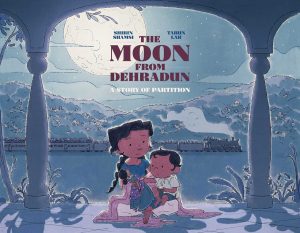 The story in The Moon from Dehradun is based on the history of the 1947 partition that created the individual countries of India and Pakistan. Prior to the partition the region had been a colony of Britain from 1858 to 1947. At the end of their rule the British divided the country according to the majority religions. Muslims must live in Pakistan and Hindus in India. Continue reading
The story in The Moon from Dehradun is based on the history of the 1947 partition that created the individual countries of India and Pakistan. Prior to the partition the region had been a colony of Britain from 1858 to 1947. At the end of their rule the British divided the country according to the majority religions. Muslims must live in Pakistan and Hindus in India. Continue reading

WOW Recommends: Chirri & Chirra In The Night
 In Chirri & Chirra In the Night, identical twins, Chirri and Chirra, hear the sounds of drums and flutes coming from the forest just as the sun is setting. Off they go on their bikes to “take a look.” They first discover an enchanting, “… black cat drink stall!” There the sisters drink multiple delicious full-moon sodas. As they drink they sprout cat tails, whiskers, ears and enhanced night vision. “They can see everything now, even in the dark.” The magic has begun! Next, their cat guides pick flowers that “Chirri and Chirra have never seen before to make necklaces for them.” The cats tell them “these will be your tickets for the festival.” Continue reading
In Chirri & Chirra In the Night, identical twins, Chirri and Chirra, hear the sounds of drums and flutes coming from the forest just as the sun is setting. Off they go on their bikes to “take a look.” They first discover an enchanting, “… black cat drink stall!” There the sisters drink multiple delicious full-moon sodas. As they drink they sprout cat tails, whiskers, ears and enhanced night vision. “They can see everything now, even in the dark.” The magic has begun! Next, their cat guides pick flowers that “Chirri and Chirra have never seen before to make necklaces for them.” The cats tell them “these will be your tickets for the festival.” Continue reading

WOW Recommends: The Eagle Huntress
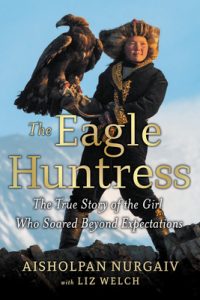 In The Eagle Huntress, a thirteen-year-old Kazakh girl named Aisholpan Nurgaiv tells the story of her journey to become the first female eagle huntress in Mongolia. It was written with Liz Welch, author of The New York Times bestseller, I Will Always Write Back. She traveled to Mongolia to write this book. The Eagle Huntress begins the day before Aisholpan was born and introduces her family’s nomadic life, moving their animals, depending on seasons, through the Altai Mountains of western Mongolia. Kazakh people lived under Communism from 1924 to 1989, when their cultural practices, including eagle hunting and nomadic life, were outlawed. Continue reading
In The Eagle Huntress, a thirteen-year-old Kazakh girl named Aisholpan Nurgaiv tells the story of her journey to become the first female eagle huntress in Mongolia. It was written with Liz Welch, author of The New York Times bestseller, I Will Always Write Back. She traveled to Mongolia to write this book. The Eagle Huntress begins the day before Aisholpan was born and introduces her family’s nomadic life, moving their animals, depending on seasons, through the Altai Mountains of western Mongolia. Kazakh people lived under Communism from 1924 to 1989, when their cultural practices, including eagle hunting and nomadic life, were outlawed. Continue reading

WOW Recommends: Berry Song
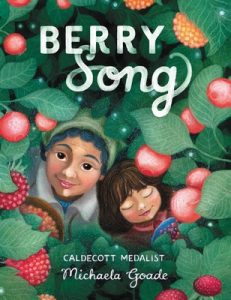 Berry Song by Michaela Goade is a celebration of the land, the indigenous people and animals that live on the “island at the edge of a wide, wild sea.” Goade grew up and lives in the Tongass National Forest which is the home of her Tlingit ancestors. The story takes place in that Forest. A young girl tells of how her Tlingit grandmother taught her to harvest what they needed from the salty ocean gathering herring eggs, seaweed and netting silvery salmon. “And in the forest… we pick berries. …The berries sing to us, glowing like little jewels. We sing too, so berry–and bear–know we are here.” As they sing they say the names of the multiple kinds of berries that they harvest. Their songs encompass the variety of ways the forest “sings to us, through misting rain and whoosh of wing, the sweet smell of cedar and the tickle of moss.” Continue reading
Berry Song by Michaela Goade is a celebration of the land, the indigenous people and animals that live on the “island at the edge of a wide, wild sea.” Goade grew up and lives in the Tongass National Forest which is the home of her Tlingit ancestors. The story takes place in that Forest. A young girl tells of how her Tlingit grandmother taught her to harvest what they needed from the salty ocean gathering herring eggs, seaweed and netting silvery salmon. “And in the forest… we pick berries. …The berries sing to us, glowing like little jewels. We sing too, so berry–and bear–know we are here.” As they sing they say the names of the multiple kinds of berries that they harvest. Their songs encompass the variety of ways the forest “sings to us, through misting rain and whoosh of wing, the sweet smell of cedar and the tickle of moss.” Continue reading

WOW Recommends: The New Rooster
 The New Rooster by Rilla Alexander is a universal and fanciful story about the challenges of communicating when many different languages are spoken. The story starts on the title page when Rooster, clutching his roller bag, parachutes from a plane. He has come a long way for his new job in a new country. We notice on the front endpapers that he has been hired to give the wake-up call at the ZZZ Hotel. But when he crows just as he had back home, no one is aroused. Even when he yells at the top of his lungs no one gets up. Repeated efforts until 3 p.m. fail to get anyone out of bed and the rooster figures he is out of a job. He realizes that he will need a good breakfast if he must make the long journey home. When the delicious smells of his cooking finally arouses the hotel guests they share a breakfast and chat. “They didn’t understand every word they heard, but they tried their best.” The ending will leave smiles on listener’s faces as this book makes a terrific read aloud. Don’t miss the punch line on the back endpapers — “Did you know the Rooster speaks pig latin?” Continue reading
The New Rooster by Rilla Alexander is a universal and fanciful story about the challenges of communicating when many different languages are spoken. The story starts on the title page when Rooster, clutching his roller bag, parachutes from a plane. He has come a long way for his new job in a new country. We notice on the front endpapers that he has been hired to give the wake-up call at the ZZZ Hotel. But when he crows just as he had back home, no one is aroused. Even when he yells at the top of his lungs no one gets up. Repeated efforts until 3 p.m. fail to get anyone out of bed and the rooster figures he is out of a job. He realizes that he will need a good breakfast if he must make the long journey home. When the delicious smells of his cooking finally arouses the hotel guests they share a breakfast and chat. “They didn’t understand every word they heard, but they tried their best.” The ending will leave smiles on listener’s faces as this book makes a terrific read aloud. Don’t miss the punch line on the back endpapers — “Did you know the Rooster speaks pig latin?” Continue reading

WOW Recommends: Blue
 Blue by Nana Ekua Brew-Hammond with illustrations by Daniel Minter is an informative and unusual nonfiction book. The beautiful illustrations extend the text that describes varied aspects of the color blue; the complicated history, impact on art, science and much more.
Blue by Nana Ekua Brew-Hammond with illustrations by Daniel Minter is an informative and unusual nonfiction book. The beautiful illustrations extend the text that describes varied aspects of the color blue; the complicated history, impact on art, science and much more.
That history started way back in time. “As early as 4500 BC, diggers found blue rocks called lapis lazuli in mines deep below Afghanistan’s Sare-e-Sang valley.” Early sources of the color came from crushed rocks and “in the belly of a certain shell fish.” Later, dyers produced blue from the indigo plants. “In parts of Africa, some merchants used strips of indigo cloth to buy people, and sell them into slavery. … In this evil side of the trade for blue, landowners around the world abused or enslaved countless people just so they could grow more indigo.” In 1905, scientist, Adolf von Baeyer, won the Nobel Prize for “creating a chemical blue.” He made that achievement after forty years of trying. Continue reading

WOW Recommends: When I Grow Up: The Lost Autobiographies of Six Yiddish Teenagers
 When I Grow Up: The Lost Autobiographies of Six Yiddish Teenagers by Ken Krimstein is a collection of “lost autobiographies” that breaks with many norms readers might expect from autobiographical works. And I predict YA literature readers will be fascinated by the power of these young people’s words and experiences and the “author’s” visual interpretation of their memoirs. Continue reading
When I Grow Up: The Lost Autobiographies of Six Yiddish Teenagers by Ken Krimstein is a collection of “lost autobiographies” that breaks with many norms readers might expect from autobiographical works. And I predict YA literature readers will be fascinated by the power of these young people’s words and experiences and the “author’s” visual interpretation of their memoirs. Continue reading

WOW Recommends: Time to Fly
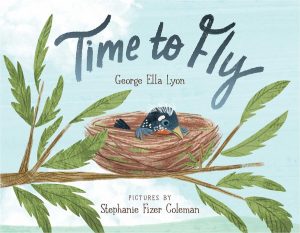 Whenever I see a new book by George Ella Lyon, I immediately take notice. Her most beloved form of writing is poetry where she provides us with eloquent lyrical verse in each of her books she delivers. I can hear her voice as I read through her books, much like the voice you hear that can be heard on YouTube videos or on her website page where you can find her reading her books and poems. In this new book, Time to Fly, I can vividly hear Lyon’s voice as she narrates a mother bird urging her last baby bird to leave the nest and learn to fly on her own. Authors who write stories where you can hear them are the types of books that I gravitate to because of their ability to be a storyteller and relay the characters’ voices brilliantly. Continue reading
Whenever I see a new book by George Ella Lyon, I immediately take notice. Her most beloved form of writing is poetry where she provides us with eloquent lyrical verse in each of her books she delivers. I can hear her voice as I read through her books, much like the voice you hear that can be heard on YouTube videos or on her website page where you can find her reading her books and poems. In this new book, Time to Fly, I can vividly hear Lyon’s voice as she narrates a mother bird urging her last baby bird to leave the nest and learn to fly on her own. Authors who write stories where you can hear them are the types of books that I gravitate to because of their ability to be a storyteller and relay the characters’ voices brilliantly. Continue reading
